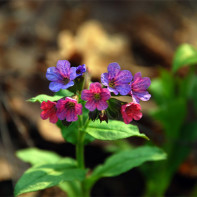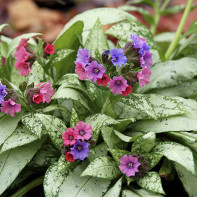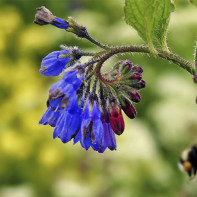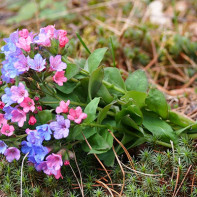Lungwort: medicinal properties and contraindications
This grass belongs to the genus of low perennial plants of the grassy species of the Burachnikov family.
- Chemical composition
- How it looks and where it grows
- Kinds
- Collection and storage
- Medicinal properties of the grass of the Lungwort
- For women
- For men
- For kids
- During pregnancy
- Lungwort in medicine
- Lunar tincture on beer with honey
- Infusion with Lungwort
- Tincture for lung diseases
- Tincture against hemorrhoids and diarrhea
- Breast collection
- Infusion for inflammation
- Tea Decoction with Lungwort
- Against kidney disease
- Salad with Lungwort and Vitamins
- Pulmonary collection
- Types of medicinal compounds with Lungwort
- Tincture
- Decoction
- Tea
- Juice
- Benefits of Honey from Lungwort
- Application in cosmetology
- For the treatment of purulent acne
- Decoction with Lungwort Leaves
- Compress
- Tincture
- Anti-aging Salad
- Rejuvenating and refreshing mask
Chemical composition
This herb contains a huge variety of vitamins and minerals. The leaves of the plant contain ascorbic acid and many other vitamins, which, of course, are very useful for a person of any age. Lungwort also contains carotene, iodine, potassium, vitamin C, silicon, iron, rutin and mucous substances. All these elements are necessary for the treatment of folk methods.
How it looks and where it grows
Lungwort has both a straight and branched stem. The plant reaches a height of 30–80 centimeters. The stem is represented by numerous sessile leaves, which are pubescent throughout their area and are located on the entire surface of the stem. As for the flowers of the plant, they gather in small curls and are located at the very top of the stems. They have a corolla shape, often funnel-shaped.
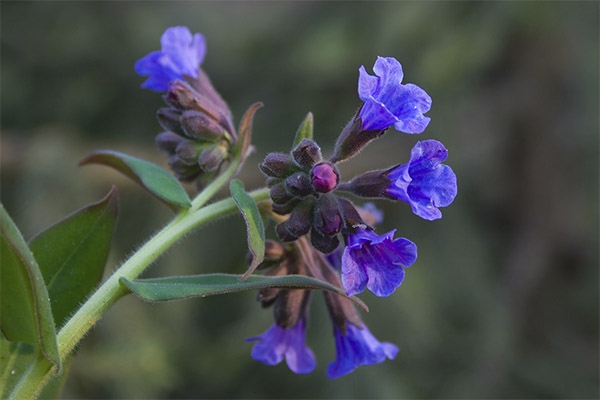
Lungwort has 2 types of flowers, which differ in shape, color and structure. Some flowers have longer columns of pestles and short stamens that hide in the corolla. Other flowers, in turn, have short columns of pistils and longer stamens. This feature allows you to prevent self-pollination of flowers, which is why cross-pollination becomes the most effective.
Different shades of inflorescences also have their own understandable explanation. The composition of the Lungwort includes plant pigments, which are responsible for the color of the petals. Due to the fact that the plant has these pigments (anthocyanins), it is common for flowers to change their shade, depending on the acid of the cell sap. Thus, young flowers have a pinkish color due to the strong acidity of their juice. During aging, the flowers gradually turn blue due to a decrease in the acidity of their juice.
Lungwort is located in most of Eurasia. It is found in territories from Western Europe to Asia Minor; in addition, it grows in Eastern Siberia. The plant prefers cool, partial shade or a completely shaded place, does not like hot weather.
Kinds
In total, from 10 to 70 varieties of Lungwort are open, but they cannot keep themselves in pure form due to pollination. Because of this, today there is no clear structure in the plant genus system. Often, for medical, cosmetic and dermatological purposes, only three species are used, which are very similar in medicinal properties and composition.
- Lungwort is unclear. Also, this plant is called dark Lungwort. This is the most common plant in Eastern Europe. The stem is ribbed and slightly bent, does not grow more than 30 centimeters in height. It blooms immediately after all the snow has melted. Her leaves are small, oblong in shape. On the entire surface of the sheet there is pubescence. The flowers of the plant are at the top of the stem. The color of the flowers in this species is often lilac, but sometimes it is white or purple. Fruits by the time of their ripening are divided into parts. Interestingly, after seed ripening, the flower falls and dies.
- Lungwort officinalis. It grows up to 30 centimeters in height. Has completely straight stems. Rough leaves, no larger than 15 centimeters.Bell-shaped flowers are located on the tops of the stem. The fruit begins to ripen in July and is a small nut. The root of this species of plant is very developed and quite thick.
- Lungwort is soft. The plant loves very bright and arid places, as well as rich soils. In height, this type of medunica reaches from 10 to 50 centimeters. The stem can be called erect and slightly glandular. The leaves of the plant are velvety and pubescent on one side, retain a green color until autumn. Leaves of this species tend to taper to the base. The flowers form curls and are located in the axils of the leaves. The fruit is a brown nut.
Collection and storage
For medical purposes, they use both the rhizome of the plant and its upper part. The top is prepared during the heyday. Flowering shoots are cut off at the very base, then they are piled and laid out in a cool room so that they can dry. Sunlight or dryers are also suitable. But the temperature should be less than 40 degrees. The main thing is to dry the raw material in a short time so that it does not turn black.
The roots, in turn, are harvested and dried for a very long time, throughout the fall. After the plants have completely dried, they should be turned into powder. It is better to store dried and crushed raw materials in small bags.
Medicinal properties of the grass of the Lungwort

- The plant copes very well with lung problems. It contains many useful substances and elements. Also in the medunica there is a huge amount of ascorbic acid, which makes it a good tool to strengthen the body. Flowers contain a substance with healing properties.
- In addition, therapeutic properties manifest themselves in expectorant and anti-inflammatory effects that appear on the respiratory tract. A decoction or infusion from this plant helps to reduce pain in bronchitis, tonsillitis, colds and coughs. Decoctions are often taken orally with a problem with the kidneys and bladder.
- It is also believed that if a person has problems with bleeding, then in this situation, a medunica can help. The plant is able to stimulate blood circulation in the human body and even stop bleeding.
- Lungwort herb may be useful in the treatment of cancer. After all, it can improve the general processes in the body, increase immunity and strengthen it.
- As for the skin, it can recover much faster when using the medunica. It enhances the regeneration of body cells.
For women
Properties of Lungwort are actively used in gynecology. Decoctions and tinctures using this herb help treat diseases of the female reproductive system. Lungwort produces a very positive effect on the hormonal system. With the help of products based on this plant, you can regulate the metabolism, stimulate the activity of the endocrine glands, and maintain the balance of hormones. Grass is used to treat hemorrhoids and to accelerate wound healing.
For men
The use of decoctions from this plant has a very good effect on men's health. Due to the fact that there are many useful elements in the grass, the Lungwort helps to treat impotence very well. You can also use decoctions from this plant and in order to prevent problems of the male genital organs. In addition, the infusions on this herb are well anesthetized and have a diuretic property. The substances and components contained in the medunica help in increasing the protective functions of the body.
For kids
To use the Lungwort is allowed for children aged strictly from 3 years. Grass strengthens the body of the child, normalizes the state of the body. Infusions from this herb help eliminate insomnia and headache, cure cough, asthma and many diseases of the respiratory system. Lungwort grass prevents diabetes, and fresh leaves help in wound healing.
During pregnancy
Doctors do not recommend treating with grass during pregnancy and subsequent breastfeeding. But it is worth noting that the caution applies solely to treatment.In the spring, when all pregnant and lactating women experience vitamin deficiency, it is allowed to add plant leaves to tea. However, you should discuss this topic with your doctor and listen to his recommendations.
Lungwort in medicine
One of the most effective methods of treatment in traditional medicine is considered to be decoctions and tinctures of the herbs of this plant. It must be remembered that no more than two or three tablespoons of the drug are allowed per day.
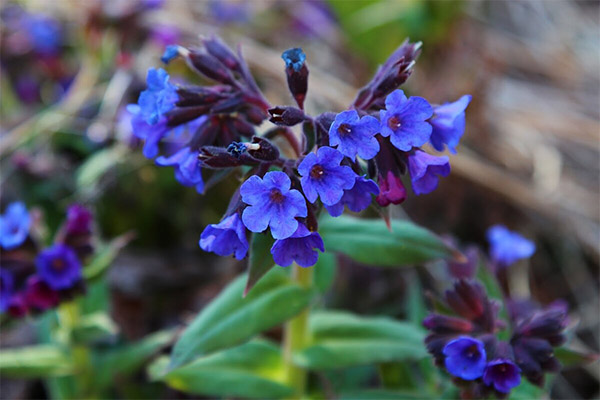
Note! The grass must be filled with hot water, since cold and warm can not properly interact with individual substances of the plant.
Lunar tincture on beer with honey
You need to take two tablespoons of the Lungwort (herbs) and pour a liter of real beer. Add a tablespoon of honey to the pan in which the ingredients are mixed. Place the infusion on the stove and cook over medium heat until the solution is less than half of the original volume. Then strain the resulting tincture. Use the infusion three times during the day, one tablespoon before a meal. You can make such a syrup for lung diseases, pneumonia. During pregnancy and lactation, you can not take a drink.
Infusion with Lungwort
To prepare this tincture, you need to take a spoonful of medunica and pour very hot water into the pan, then let it brew for two hours. Take one mug daily. It is advisable to divide into several methods. Such a tincture with Lungwort is allowed to treat bronchitis, even chronic, also used in situations where the voice is hoarse. A decoction is used for kidney disease and hemorrhoids. It is used to treat tuberculosis in a child, but you should first consult a doctor.
Tincture for lung diseases
To prepare this tincture, you need to take two tablespoons of the honeyfish, previously dried, pour boiling water over it and let it brew for four hours. Then remove all the grass from the solution and drink 160 milliliters daily, three times a day 30 minutes before meals. To increase the effect of diseases of the respiratory system, you can add other herbs to the tincture, such as thyme.
Infusion is allowed to be used externally - in the form of a bath, washing and rinsing. It is prepared according to the same principle, but it is necessary to take more dry grass, namely four tablespoons instead of two.
Tincture against hemorrhoids and diarrhea
In order to prepare a very simple and useful infusion, you need to take 100 g of the honeyfish, previously dried, and pour a liter of boiling water. Let the tincture infuse for two hours. Then strain the solution and remove grass from it. Use two to three times a day for half a cup. To achieve a good effect, it is necessary to mix the grass of the Lungwort with the seeds of flax in equal proportions.
Breast collection
Lungwort herb is one of the ingredients of breast collection, which is used as a very effective expectorant for sore throat, cough and bronchitis, colds, rhinitis and many other diseases associated with the respiratory organs. To prepare the collection, it is necessary to take in equal parts such ingredients as oregano, coltsfoot, linden, mint, thyme, violet, pine buds and medunica.
Fill two spoons of this collection with hot water in the volume of half a liter and send to infuse for two hours. Take a collection of half a glass, three times a day before meals. One course of treatment is two weeks.
Infusion for inflammation
In order to prepare the tincture, you need to take four tablespoons of the leaves of the medunica, previously chopping them, pour two cups of very hot water and leave to infuse for four hours. Take the infusion with the addition of a sweetener in three tablespoons, no more than 5-6 times a day. This tincture can help not only with inflammation, but also with diarrhea and cramping. Outwardly, it can be used for inflammation of the skin and mucous membranes. For the treatment of hemorrhoids and female diseases, tincture is prepared in the same way, only the fortress should be larger.
Tea Decoction with Lungwort
To make tea with Lungwort, you can take a spoonful of dry grass of Lungwort and pour a little hot water into it. Then let the tea brew for 15 minutes or more. After the drink is infused, strain. Lungwort tea is rather bitter, which is why honey or sugar and a little lemon juice should be added to the cup. Drink tea with Lungwort at least 3 times throughout the day.
Against kidney disease
To prepare this collection, you need to add one part to each container from each of the herbs: Lungwort, plantain, sage, wormwood. Gather the grind very finely. After chopping, pour the collection spoon with one cup of boiled water and add a little honey. Next, boil the solution over medium heat for 5-10 minutes. Then let it cool. It remains only to filter the collection. Use the decoction on the dining room bed three times a day before eating.
The second option: take the same parts of the grass of the Lungwort, a leaf of lingonberry and currant. Pour all this with very hot water (500 milliliters) and let it brew for about half an hour. The capacity in which the collection will be insisted is not so important, later it will be possible to transfer it to a convenient container. Take about 5 times a day, two tablespoons before meals.
Salad with Lungwort and Vitamins
To prepare this nutritious and simple salad, you need to take the leaves of the Lungwort, chicken eggs (the amount depends on the number of servings) and a bunch of green onions. The ingredients, like the preparation itself, are very simple. You can fill the salad with anything, sour cream, butter, mayonnaise - to the taste of whoever will eat this dish. The salad is also made with other ingredients, adding radish, radish, or lettuce. Interestingly, grass lungwort, its leaves or flowers can be added to everyday food, soup, okroshka or green borsch.
Pulmonary collection
This fee is allowed to be used for the prevention and treatment of bronchitis and many other diseases. To prepare it, you need to take two teaspoons of calendula and linden, and then mix it all in one large container. After that add exactly the same amount of other ingredients, namely: Lungwort herb, Althea root, nettle leaves, violet, ledum, and coltsfoot. Take two tablespoons of each ingredient and add to the mixture. Only after all these ingredients are added and well mixed with the previous ones, add a teaspoon of pine buds, elderberry inflorescences and elecampane roots. All ingredients must be well ground before adding to the collection. Then mix everything very carefully. After mixing three tablespoons of this collection, pour into a container in which the solution will be brewed. It can be a thermos, a can, a pan or something else. Collect pour three cups of boiling water and leave to infuse. The time during which the solution cannot be touched is 8 hours. After this time, strain the liquid well through a sieve. The best option is to cook in the evening to leave to insist on the night. In the morning, the solution will be ready for use.
Types of medicinal compounds with Lungwort
There are several types of medicinal compounds, which include the grass of the medunica, its flowers, stems and more. Also in their composition are often other herbs and plants that have a very positive, calming, healing effect on the human body. What is important, they are very easy to cook on their own, and everyone can do it. Below are some of them.
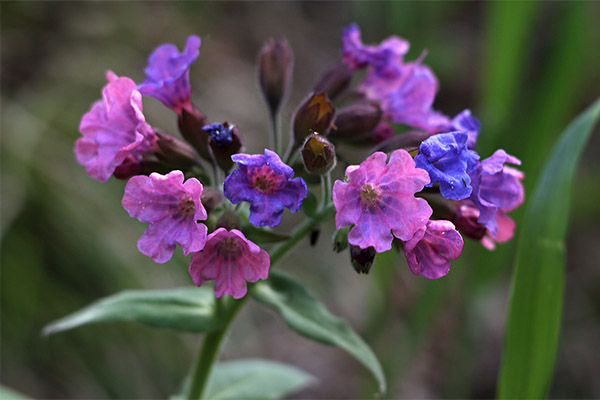
Tincture
Tincture of Lungwort helps to cope with diseases of the respiratory organs, bronchitis, bronchial asthma, pneumonia, anemia. For its preparation, dried pre-raw materials are used (different amounts, it all depends on the recipe), which must be poured with boiling water. The liquid should be infused for 14 days or more.Then strain the solution. Tincture is allowed to be used inside several times throughout the day before meals and externally - for washing, rinsing, compresses.
Decoction
A decoction is a mild, expectorant that is used for coughing, colds, and respiratory problems. In order to prepare a decoction, it is necessary to pour a handful of dry grass of the Lungwort with a half liter of water. Bring the liquid to a boil, cook for 15–20 minutes. After cooking, strain the liquid and drink a couple of times throughout the day.
Tea
For its preparation, you need fresh or dry parts of the plant of the lunatic They just need to be brewed instead of regular tea. Lungwort has a huge variety of useful and healing properties. Reception of tea from this herb is the prevention of various diseases, it will be useful for both children and adults.
Juice
The juice of this plant is very useful for any skin problems due to the fact that it has many beneficial substances. Making juice is pretty simple. It is necessary to take a small amount of lungwort (if you want more juice, then it is better to take the grass, which was picked later), then use a technique (blender) or a plate and spoon to turn it into pulp. Then strain the resulting slurry through a sieve. You will get juice, which must be diluted with water in a ratio of 1 to 10. You can drink three teaspoons a couple of times a day.
Benefits of Honey from Lungwort
Many beekeepers show great love for the Lungwort. And there are several reasons for this. It blooms in the spring, and more specifically in mid-April, and is one of the early honey plants. The heyday of the plant is about a month, while a huge amount of nectar is released. The flowers themselves of this plant are very fond of bees.
The honey that is collected from the Lungwort is an incredibly valuable product for the bees themselves and the entire bee family. It is during the collection of honey that the uterus lays eggs very actively. And worker bees at this time make up for lost strength and fodder reserves.
For customers, honey lunar honey is also a very valuable product, as it helps to strengthen the body, helps get rid of coughs and colds. But with all the positive qualities of this product, you should approach its use with great care. This is because honey with Lungwort has the power to provoke severe irritation of the mucous membrane in the mouth.
You can also not consume honey for people who are allergic to this product.
Application in cosmetology
The plant is often used in cosmetology, due to the fact that the herb has anti-inflammatory, wound healing, cleansing, anti-aging properties. In addition, the Lungwort has the ability to stimulate hair growth, prevent and prevent hair loss.
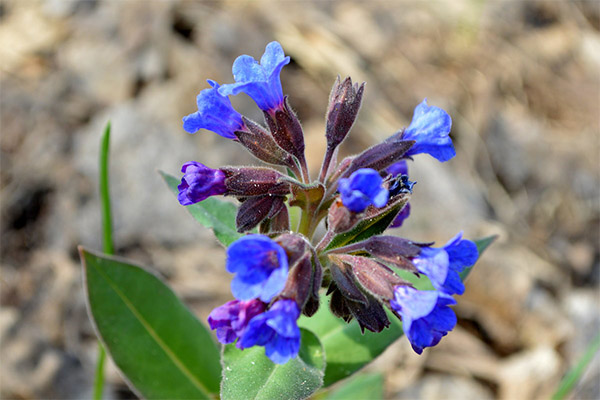
Lungwort is the best ingredient for strengthening hair. The plant shows its properties in the form of a powder, which is used for quick healing of wounds and as an anti-inflammatory drug. Also, warm tinctures with this herb are prescribed as compresses for external use. Warm tinctures are used for washing, for acne, wounds, abrasions, ulcers.
For use in cosmetology, the aerial part of the plant is harvested during its flowering period.
For the treatment of purulent acne
For the treatment of purulent acne, as well as reddened skin, compresses should be done. To create them, you need to take two tablespoons of dried leaves of the grass of the Lungwort, pour half a glass of boiling water. Allow time to infuse, after which put the still not cooled gruel in gauze and attach to the lesion.
The second option: four tablespoons of dry grass of the honeyfish or leaves and flowers pour a glass of boiling water, boil for 5 minutes, then strain the solution. Then moisten napkins in this liquid and attach to the lesion site.
Decoction with Lungwort Leaves
A decoction with leaves of Lungwort is also very widely used internally for various diseases, as well as externally on inflamed skin, for compresses and rinses. To prepare it, you need 50 grams of dry grass (or a little less, if you use fresh), pour boiling water in the proportions of 1 to 2 or 1 to 3 (it all depends on the doctor's recommendations, because different cases require a different concentration of solution). Then let the solution brew for half an hour. As soon as time runs out, the remedy can be consumed.
Compress
Usually, after using the broth, the gruel from the herbs remains, it is allowed to use it in the form of compresses that are applied externally, in order to treat psoriasis, dermatitis, a fungal rash and so on. To prepare compresses, put the porridge on cheesecloth, then wrap the edges and get a bag that is applied to an irritated place on the skin. The approximate time it takes to apply a compress is 10-15 minutes. If desired, repeat the procedure several times a day. If the compress is infused in alcohol, then it will begin to have warming and antiseptic properties.
Tincture
You can use tincture in the same way as with other means and solutions - inside, for the prevention and treatment of diseases of the respiratory organs, and externally, for the prevention and treatment of diseases that are associated with the skin. To prepare it, take 30 grams of a fresh plant of Lungwort, pour vodka in a ratio of 1 to 15 and let the solution brew for about 15–20 days. The infusion should acquire a bright yellow, red or brown color. After this, strain the solution and pour into another container.
Anti-aging Salad
The ingredients are very simple, all that is needed for a salad: 45-60 grams of honey, a bunch of green onions, a little parsley and dill, juice of half a lemon and oil to taste and if desired. Rinse all ingredients well under running water and grind. Mix everything, season with olive oil and lemon juice. There is a salad every day for two to three weeks, only then will a positive result be noticeable.
Rejuvenating and refreshing mask
For its preparation, it is necessary to take equal parts of the medunica, linden leaves, clover flowers and mint in any form. All ingredients must be dried and finely ground. Pour boiling water over this whole mixture of herbs and let it brew for 40 minutes. The consistency of sour cream should turn out, so you should add boiling water to the desired density. After that, apply the finished mask to all exposed areas of the body, namely to the face, décolleté and hands. Keep the mask for 15 to 20 minutes, then rinse it off in warm water without using soap. Repeat this procedure every week.
The advantage of this mask is that it is suitable for all skin types. The composition is especially good for women whose age has passed the mark of 35 years. The mask, of course, does not have an upper age limit. It moisturizes the skin, nourishes and cleanses it.
«Important: all information on the site is provided exclusively in fact-finding purposes. Before applying any recommendations, consult with a profile specialist. Neither the editors nor the authors are liable for any possible harm caused materials. "

